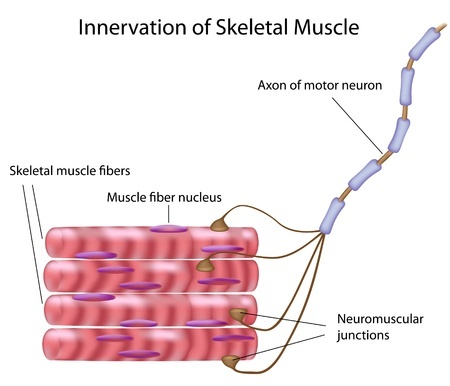Neuromuscular Re-education in Orthopaedic Physical Therapy

Tid Bits of Info
- The only way to re-develop “normal” motion with in an injured body part is to perform prescribed motions.
- Initially perform all motions slowly and methodically. The nervous system needs time to “map” the motions. Poor form can lead to bad movement patterns.
- Any strength gains with in the first 3-4 weeks of a strength building routine will occur due to an increase in the efficiency of the neuromuscular activity.
- Use proper form and experience very little to no joint pain when you are exercising.
- Sharp pain will decrease the neural input into the involved body part.
- Seek the advice of your Physical Therapist to rehabilitate your injuries properly.
Out-patient Physical Therapist re-educate the nervous system with almost every patient. Neuromuscular re-education techniques help patients regain normal, controlled movement patterns. The nervous system controls most of what we can do, so orthopaedic physical therapy almost always includes neuromuscular re-education as a part of the overall recovery regimen.
Neuromuscular Re-education in Out-patient Physical Therapy
Neuromuscular re-education consists of manual techniques (i.e.PNF-proprioceptive neuromuscular facilitation), activities for balance and core control (i.e Bosu exercises and Therapeutic Ball exercises) and other therapeutic exercises that are designed to re-develop normal, controlled movement patterns. The goal of neuromuscular re-education activities in the out-patient orthopaedic setting is the same as it is in any other setting: to re-train a body part to perform some task that the body part was previously able to do.
When is Neuromuscular Re-education Employed?
Neuromuscular re-education techniques may be applied in a range of situations. In our setting, the need to re-establish normal kinesthetic sense and proprioception of the Cervical, Thoracic, Lumbar spine and Appendicular skeleton is critical to eliminate many of the symptoms that a patient presents with during their treatment time. When these neurological characteristics are not functioning properly, a patient cannot maintain proper posture and many of the muscles of the involved area do not function properly.
A range of techniques may be used to “retrain” the nerve signals and rebuild muscle memory through repeated, movement patterns. Multiple muscle physiology and strength training journals agree that neural adaption precedes a strength change in the form of hypertrophy or hyperplasia of the muscle cells. The patient experiences increased strength in the first 3-4 weeks based on this neural adaption. It is referred to as an enhancement of neurological “communication” with the motor end plate and the number and frequency of neural impulses is increased within a particular motor unit. This helps to re-establish and re-educate the “normal” neural control that is needed for a patient to experience movement patterns that do not have abnormalities, which can lead to musculoskeletal conditions.
Anyone who has spent any time in the out-patient orthopaedic physical therapy setting has witnessed the loss of neuromuscular control in an involved body part. Pain, inflammation and swelling due to surgery or traumas like rotator cuff injuries can lead to loss of neural muscular control and abnormal movement. Healthcare professionals can attest to the fact that in these situations the muscle cannot perform any action without a neural impulse.
A denervated muscle (the nerve cannot transmit a neural signal to the muscle) can be stimulated with an exterior direct electrical current, but is 100% non-functional (paralyzed) if the nerve is not capable of delivering the electrical impulse to stimulate the motor end plate and begin the contraction process. Any reduction in neural input to that muscle’s motor end plate(s) will have a negative effect on the muscle’s ability to function properly.
Many of our patients have general tenderness, hypo-mobility and decreased motion of a joint(s). It is necessary for a joint(s) to have full motion to be fully functional. If the joint does not articulate through its full range of motion via muscle contraction, there will be weakness and functional limitations that will develop over time. This time period is different for every patient, but several weeks to months is not out of the ordinary when the symptoms are not treated properly. Any loss of motion and strength needs to be addressed to eliminate the patient’s symptoms and correct the “problem.” Re-education of the nervous system must occur prior to developing enough strength and motion to regain full function. Without the neuromuscular re-education process, there is no way that the “normal” movement patterns can be re-established.
Neuromuscular re-education plays a major role in the out-patient, orthopaedic Physical Therapy setting. If the proper techniques, activities and exercises are not performed on an injured body part, an acute injury can develop into a chronic situation. Most of the active rehabilitation treatments that occur in the acute and sub-acute phase of healing are truly re-educating the nervous system more than dealing with the muscles and other soft tissue. Re-developing normal movement patterns and functional capabilities can only occur if the nervous system is in control of the musculoskeletal system.


























I have read your outline regarding Neuromuscular Re-education in Orthopaedic PT. I also agree with the comment Ryan has provided above. I am a survivo of a CVA from August 2007. I still have some Neuromuscular issues that have not been addressed to date, and finding this information is a new step in the right direction. I do have a need for a therapist here in the Los Angeles, CA area. Any help, or referral you can offer would be greatly appreciated.
As this article states every patient requires some form of neuro-muscular reeducation. It is especially important when you have patients who have sustained a CVA. Their muscles are already lacking the necessary nerve impulses needed to obtain a full muscle contraction. For these individuals it is less of building strength as it is reteaching the muscles how to fire and react to different postural changes.